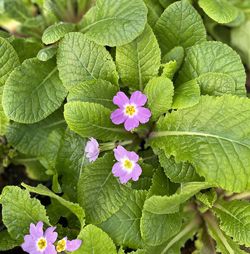(S. pendula) Nodding Sage
Salvia
Sage
Thought in ancient times to perpetuate good health, an Arab proverb asks, “How shall a man die with sage in his garden?” Our Salvias are diverse perennials, shrubs or subshrubs, many hailing from the Mediterranean, Mexico, South America and some of our western states. Reliable once established, and generally undaunted by pests, disease and drought, they combine an array of flowers and often aromatic foliage in many different sizes, shapes and hues.
Each 11.25
Though Linnaeus named this wildly unusual Salvia way back in the 1700s, you’ll be hard pressed to find it growing in anyone’s yard these days. Endemic to the Balkans, eastern Europe, Turkey and southwestern Russia, Nodding Sage sprouts an attractive low basal rosette clothed with large, textural arrowhead-shaped greenery beneath the perfect-for-cutting, pollinator-friendly posies, which look a bit like Wisteria blooms. The splendid, long-lasting blue-violet blossoms populate striking close-knit pendant clusters, gracefully flowing from the tips of sturdy, wide-branched, 4 ft. tall, reddish flowering stalks. Undeterred by hot humid summers, winter cold and light shade, Salvia nutans can embellish well-drained borders, rock gardens or natural-style plantings.
Blooms June–September
Size: 3' 0" – 4' 0" high x 12" – 18" wide.
Zone 5b/6.
Please fill out our Registration Form to receive news of updates to the web site, availability of new plants, give us your feedback, and to be on the mailing list to receive future printed catalogs.
Other selections in this genus:
- Salvia x ‘Allen Chickering’
- Salvia argentea
- Salvia arizonica
- Salvia azurea ‘Grandiflora’
- Salvia azurea ‘Nekan’
- Salvia ‘Bee’s Bliss’
- Salvia x ‘Big Swing’
- Salvia brandegeei ‘Pacific Blue’
- Salvia cacaliifolia
- Salvia chiapensis
- Salvia clevelandii ‘Whirly Blue’
- Salvia clevelandii ‘Winnifred Gilman’
- Salvia confertiflora
- Salvia corrugata
- Salvia ‘El Cielo Blue’
- Salvia ‘Eveline’
- Salvia forsskaolii
- Salvia glechomifolia
- Salvia greggii ‘Lowry’s Peach’
- Salvia x ‘Nuevo Leon’
- Salvia greggii ‘Wild Thing’
- Salvia guaranitica ‘Black and Blue’
- Salvia guaranitica ‘Blue Ensign’
- Salvia holwayi
- Salvia involucrata ‘Hidalgo’
- Salvia involucrata ‘Mulberry Jam’
- Salvia x jamensis ‘Pat Vlasto’
- Salvia leucantha x elegans ‘Anthony Parker’
- Salvia ‘Madeline’
- Salvia melissodora (Yucca Do Form)
- Salvia mexicana ‘Compton’s Form’
- Salvia mexicana ‘Limelight’
- Salvia mexicana ‘Tula’
- Salvia microphylla
- Salvia microphylla ‘Dennis’ Pink’
- Salvia microphylla x greggii ‘Red Velvet’
- Salvia microphylla ‘Hoja Grande’
- Salvia microphylla ‘San Carlos Festival’
- Salvia microphylla ‘Wild Watermelon’
- Salvia moorcroftiana ssp. x indica
- Salvia nemorosa ‘Amethyst’
- Salvia nemorosa ‘Blue Marvel’
- Salvia nemorosa ‘Caradonna’
- Salvia nemorosa ‘Midnight Rose’
- Salvia nemorosa ‘Negrito’
- Salvia nemorosa ‘Rosenwein’
- Salvia nemorosa ‘Sensation Deep Rose’
- Salvia nemorosa ‘Wesuwe’
- Salvia nemorosa ‘Schwellenburg’
- Salvia nubicola
- Salvia ‘Phyllis Fancy’
- Salvia ‘Pozo Blue’
- Salvia pratensis ‘Sky Dance’
- Salvia pratensis ‘Swan Lake’
- Salvia pratensis ‘Sweet Esmeralda’
- Salvia pratensis ‘Twilight Serenade’
- Salvia przewalskii
- Salvia ‘Purple Majesty’
- Salvia purpurea ‘Lavender Lace’
- Salvia reptans
- Salvia reptans ‘West Texas Form’
- Salvia sclarea ‘Vatican White’
- Salvia semiatrata
- Salvia ‘Silke’s Dream’
- Salvia sinaloensis
- Salvia x sylvestris ‘Dear Anja’
- Salvia x sylvestris ‘Tanzerin’
- Salvia uliginosa
- Salvia ‘Ultra Violet’
- Salvia urica
- Salvia vanhoutii (Burgundy Form)
- Salvia verticillata ‘Purple Rain’
- Salvia ‘Waverly’










